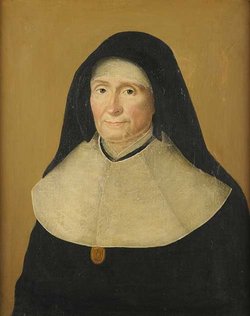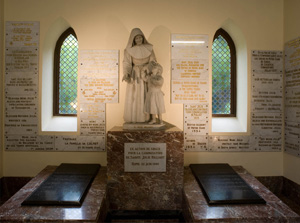(Marie-Louise-Françoise Blin de Bourdon)
Françoise was born in 1756 into one of the oldest families of Picardy in Gezaincourt, France. She was the third and last child of Pierre-Louis Blin de Bourdon, Viscount of Domart and Ponthieu, who had married Marie-Louise-Claudine de Fouquesolles, daughter of the Baron of Fouquesolles, Viscount of Doullens. Her brother was Louis-Marie-Cesar and sister was Marie-Louise-Aimee. Unlike her friend, Julie, Françoise was educated firstly by governesses and later at the Benedictine and Ursuline schools.
Prior to the Revolution, as Vicomtesse Blin de Bourdon, Françoise had devoted her life to the good management of her estates and to caring for the poor and sick. She hoped one day to become a Carmelite Nun.
Following the death of Robespierre, Françoise was freed from imprisonment and her friend, Madame Baudoin, brought Julie Billiart and her niece, Felitité, to Amiens. They acquired a small apartment in the town home of Françoise Blin's brother on the rue des Augustins in Amiens. Madam Baudoin invited Françoise to meet Julie. Françoise responded to the invitation but in the beginning she found she could not understand the invalid's laboured speech. However as the days passed, Françoise would read to Julie and help feed her. Gradually, Julie's winning personality triumphed over her physical limitations, and what began as a work of mercy was transformed into one of the most beautiful examples of a spiritual friendship between two women in the recorded history of religious life.
In 1816, after the death of Mother Julie, Sr Saint-Joseph is elected Superior General and will remain so until the end of her life. She faithfully continues the work of her friend; she draws up the rule, completes the foundations at Liège and Dinant and creates those at Thuin, Verviers, Philippeville and Bastogne.
Her big concern will be to keep the unity of the Congregation under the Dutch regime between 1815 and 1830. To this end, she accepts naturalization as a citizen of the Netherlands, takes the exams before State examiners and takes charge of hospices since schools are no longer viable. In 1815, in spite of the opposition of some sisters, she preserves intact the spirit of the Institute.
She dies at Namur on February 9, 1838. She leaves an abundant correspondence in which are evident her realism, her openness, and her knowledge of the human person, as well as her supernatural spirit.
(Marie-Louise-Françoise Blin de Bourdon)
Françoise was born in 1756 into one of the oldest families of Picardy in Gezaincourt, France. She was the third and last child of Pierre-Louis Blin de Bourdon, Viscount of Domart and Ponthieu, who had married Marie-Louise-Claudine de Fouquesolles, daughter of the Baron of Fouquesolles, Viscount of Doullens. Her brother was Louis-Marie-Cesar and sister was Marie-Louise-Aimee. Unlike her friend, Julie, Françoise was educated firstly by governesses and later at the Benedictine and Ursuline schools.
Prior to the Revolution, as Vicomtesse Blin de Bourdon, Françoise had devoted her life to the good management of her estates and to caring for the poor and sick. She hoped one day to become a Carmelite Nun.
Following the death of Robespierre, Françoise was freed from imprisonment and her friend, Madame Baudoin, brought Julie Billiart and her niece, Felitité, to Amiens. They acquired a small apartment in the town home of Françoise Blin's brother on the rue des Augustins in Amiens. Madam Baudoin invited Françoise to meet Julie. Françoise responded to the invitation but in the beginning she found she could not understand the invalid's laboured speech. However as the days passed, Françoise would read to Julie and help feed her. Gradually, Julie's winning personality triumphed over her physical limitations, and what began as a work of mercy was transformed into one of the most beautiful examples of a spiritual friendship between two women in the recorded history of religious life.
In 1816, after the death of Mother Julie, Sr Saint-Joseph is elected Superior General and will remain so until the end of her life. She faithfully continues the work of her friend; she draws up the rule, completes the foundations at Liège and Dinant and creates those at Thuin, Verviers, Philippeville and Bastogne.
Her big concern will be to keep the unity of the Congregation under the Dutch regime between 1815 and 1830. To this end, she accepts naturalization as a citizen of the Netherlands, takes the exams before State examiners and takes charge of hospices since schools are no longer viable. In 1815, in spite of the opposition of some sisters, she preserves intact the spirit of the Institute.
She dies at Namur on February 9, 1838. She leaves an abundant correspondence in which are evident her realism, her openness, and her knowledge of the human person, as well as her supernatural spirit.
Advertisement
Advertisement



